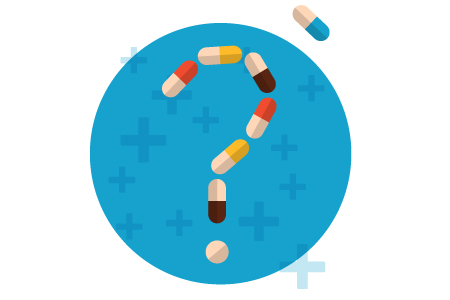Should Drug Repurposing Be A Part Of Your Strategic Plan?
By Ed Miseta, Chief Editor, Clinical Leader
Cures Within Reach has been around since 1998, but the nonprofit, which started as a family foundation, did not become a public charity until 2005. The organization has primarily been funding medical research to accelerate the search for cures, but by 2010 its 190 de novo (new drug) projects had not touched the life of a single patient.
 Ten other projects, which happened to be research on drug repurposing (finding a new indication for an existing medicine) had four successful outcomes, with medicines being used in clinics to save and improve lives.
Ten other projects, which happened to be research on drug repurposing (finding a new indication for an existing medicine) had four successful outcomes, with medicines being used in clinics to save and improve lives.
“At that time, we realized no one else was really focused on drug repurposing, especially with generic drugs,” says Dr. Bruce Bloom, president and chief science officer for Cures Within Reach. “We decided that should be our mission, and that is where our focus has been for the last five years. Since then, 50 of the projects we have funded have been proof-of- concept clinical trials for drug, medical device, and nutriceutical repurposing. Twelve therapies are either being used clinically or are in Phase 3 trials on their way to commercialization.”
The benefits of repurposing an existing drug, especially a generic, are huge. Cures Within Reach will start with a drug that is known to be safe and effective in humans. That enables a significant amount of time and cost to be removed from the process. “Many of the hurdles you face with a new drug simply disappear,” says Bloom. “Sometimes we are able to get a new repurposed therapy from ideation to patient use in three years or less, and for under $500,000. That is a substantial savings over the 10 to 20 years and $2 billion you might face for de novo research. Knowing the drug is already safe for use in humans can speed up both the IRB (institutional review board) and the FDA IND (investigational new drug) approvals.”
“If there is a rare disease with no known cure, clear results from a robust clinical trial on a repurposed drug will often be enough to convince a physician the solution created is safe, inexpensive, and a good treatment option for their patient,” says Bloom. “They also see the results in publications and talk to other physicians about it and then opt to prescribe it off-label to their patients.”
For some indications, there may be a change in the drug that creates some commercialization value because it provides intellectual property protection. In those cases, Cures Within Reach will find a company to pick it up and move it through the regulatory pipeline. The organization’s supported research has created several devices and compounds currently moving in that direction. Still, most of its efforts revolve around repurposing generic drugs. Because generics generally have multiple manufacturers, it can be easier to get donations of the drug for the clinical trial.
DRUG COSTS ARE A CONCERN
The cost to the healthcare system is always a concern whenever a new drug hits the market. Although new medicines will make patients healthier, they will almost always cause a significant increase in the cost of healthcare. When a repurposed drug comes out, it will also make patients healthier but will often decrease the cost of healthcare.
“In a lot of the rare diseases we have worked on, the patients were sick and there was no treatment option available,” notes Bloom. “Some of those patients may have been hospitalized for significant portions of their lives, at a cost of up to $100,000 per year. With an effective repurposed drug, many of those other healthcare costs can disappear, and the cost of caring for that patient might fall to maybe $5,000 per year. As a result, both the patient and the healthcare system benefit.”
Bloom provides a couple examples of the benefits that can arise from repurposing. Cures Within Reach is hoping to start a global project with a number of industry and nonprofit partners in 2016. The goal is to determine whether Metformin, a Type-2 diabetes drug, can help patients with tuberculosis (TB). Metformin has been around for many years and is used by hundreds of millions of people around the world. It also seems to have an effect on the tuberculosis bacteria, making it more susceptible to antibiotics.
“Our study will add Metformin to the anti-infective protocol for TB,” says Bloom. “Right now, TB is so drug resistant that patients have to take four medications simultaneously. For many patients, that combination still doesn’t work. It appears adding Metformin to the mix might increase the number of patients benefiting from the treatment and also decrease the amount of time they have to take the drugs.”
Another example is sildenafil (Viagra), which is now being tested as an anticancer treatment. Bloom notes tumor cells have numerous ways of escaping the body’s immune system and continuing to grow out of control. For that reason, chemotherapy treatments will often destroy some, but not all, of the tumor. By adding sildenafil, which blocks one way cancer cells grow uncontrollably, to the treatment regimen, more of the standard chemo treatment is able to shrink the tumors.
FIRMS HAVE DIFFERENT GOALS
While pharma performs the drug discovery function well, attempting to repurpose a medicine is not always in their best interest. If a company has a blockbuster drug bringing in $2 billion per year treating diabetes in patients over the age of 45, that company would certainly want to protect its cash flow.
Even if the medication seems to hold promise as a cure for a rare or common pediatric disease, pursuing that indication can be risky. If a child were to get sick or die, or if it caused a growth disturbance in those children, the blockbuster drug will suddenly have a black mark on it. For that reason, pharma has to be very careful about what part of the life cycle they choose to go after when repurposing.
Pharma companies also have more good opportunities than they can often manage internally. For that reason, they will often outsource the repurposing. According to Bloom, they may opt to license that repurposing opportunity to a small biotech. The other company can absorb some of the financial and other risks while providing the pharma company with first refusal to relicense it back at a later date.
“As a not-for-profit organization, we are starting to get more requests from pharmaceutical companies for ideas to repurpose some of their end-of-lifecycle compounds,” states Bloom. “By getting a method-of-use patent on a new disease indication, they might be able to extend the patent life of that drug, or at least their branded version of it. When a drug comes off patent, anyone can make it. But if you are the only company that can market it for the new disease indication, you may be able to maintain some of that market share.”
NEITHER RESEARCHER NOR FUNDER
Cures Within Reach is not a venture capital firm. It does not invest in research, it does not develop molecules, and it does not conduct research. But its ability to get needed medicines to patients in need cannot be overestimated. Bloom would like companies to think of the organization as a facilitator. Most of the repurposing research takes place at an academic research partner, and the organization is neither the researcher nor the funder … it just brings together the key players.
The nonprofit will find projects and have them scientifically vetted to determine the chances of the project delivering the desired patient impact outcome. Then, Cures Within Reach locates the needed funding and brings all of the pieces together. If the group is working with a pharmaceutical company, that company may be the funder but will not be involved in the actual research. There is a fundamental value to that because being a nonprofit means the organization gets a really good deal from its research institution partners.
“If a large pharmaceutical company goes to an academic research institution to conduct a study, it might cost them $2.5 million,” says Bloom. “We might be able to get that same project done for under $400,000. The reason is that these partner institutions do not charge us for many costs, including institutional overhead and investigator salaries. They will charge us a bare-bones price because it is generally their repurposing idea, and they want to prove that it can work for patients. If a principal investigator at an academic research institution comes up with the idea, we line up the funding for them, and they are excited about the possibility of having their idea help patients.”
More than 90 percent of Cures research partners are in academia, with the rest being small biotech firms. All funding comes from pharma companies, family foundations, disease-specific nonprofits, and individual philanthropists. Bloom states the organization has never had to work with CROs but would be happy to do so under the right circumstances. Most projects do not have to go through regulatory approval, so the expertise of a CRO is generally not needed. He believes that situation may change going forward and would be interested in obtaining pro-bono support from large CROs.
MAKE RESEARCH A WIN-WIN
Pharma companies can benefit from repurposing research because Cures Within Reach has a new Web platform, CureAccelerator, that lists repurposing research ideas from around the world, most originated by researchers and clinicians who otherwise might have no contact with a pharmaceutical company. The CureAccelerator Web platform can provide protection for the project’s intellectual property as the ideas are moved through to proofof- concept clinical trials quickly and inexpensively.
Often, when repurposing a drug, it shows promise for a new disease indication but does not ultimately deliver the desired result. Even in those cases, it might provide a tremendous amount of new data about pathways and molecular mechanisms that allows the pharma company to create new approaches. Bloom cites Thalidomide as an example. Once its mechanism of action was understood, Celgene was able to take the drug with a nefarious past and use it as the backbone for a series of new medicines that are analogs of Thalidomide.

"Nobody but government or philanthropy is likely to fund the repurposing of a generic drug with no profit potential."
Dr. Bruce Bloom
President and CSO, Cures Within Reach
“We may eventually find out that Metformin has an effect on TB but is not the ideal treatment for that indication,” notes Bloom. “With that information, another company might attempt to tweak it a little and perhaps create a better product. Add IP protection to that effort, and they have the opportunity to generate revenue from it. Some physicians might opt to use Metformin while others opt for the new drug. In that instance, our attempts to repurpose can act as a launch pad for new and better ideas.”
Cures Within Reach currently has no government support, but Bloom notes efforts are being made to start to work with the NIH. “They [the NIH] have invested time in looking at shelved pharmaceutical compounds to see if they can find new indications for them. We have been pushing hard for them to do the same thing for generic drugs. Nobody but government or philanthropy is likely to fund the repurposing of a generic drug with no profit potential. We believe governments need to do that so we can expand this repurposing revolution and drive more treatments more quickly to more patients.”
